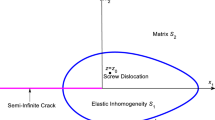Abstract
The dynamic stress intensity factor for a stationary semi-infinite crack in an elastic plane due to the rectilinear motion of a screw dislocation is obtained analytically. The intensity factor is studied for its dependence on the (initial) dislocation position, orientation and speed. The speed is subsonic and possibly non-uniform. The position and orientation are arbitrary, so that crack-dislocation intersection is considered. It is assumed that a dislocation traveling toward the crack surface arrests upon arrival. It is found that, in general, dislocation motion initiation and arrest cause discontinuities in the intensity factor. In the latter instance, the factor takes on a constant value and, in the case of arrest on the crack surface, this value depends only on the initial dislocation position.
Similar content being viewed by others
References
J.D. Eshelby, F.C. Frank and F.R.N. Nabarro, The equilibrium of linear arrays of dislocations, Phil. Mag. 42 (1951) 351–364.
B.A. Bilby and J.D. Eshelby, Dislocations and the theory of fracture. Fracture, Vol. 1 (H. Leibowitz, ed.). Academic Press, New York, 1968, Chapter 2.
T. Yokobori, A.T. YokoboriJr. and A. Kamei, Dislocation dynamics theory for fatigue crack growth, Int. J. Fracture Mech. 11 (1975) 781.
J.R. Rice and R. Thomson, Ductile versus brittle behavior of crystals, Phil. Mag. 29 (1974) 73–97.
J. Tirosh and F.A. McClintock, Finding elastoplastic stress and strain in cracked bars under torsion by assembling screw dislocations, Engng. Fracture Mech. 11 (1979) 563–571.
C. Atkinson, The interaction between a dislocation and a crack, Int. J. Mech. 2 (1966) 567–574.
K.K. Lo, Analysis of branched cracks, J. Appl. Mech. 45 (1978) 797–802.
W.G. Johnston and J.J. Gilman, Dislocation velocities, dislocation densities, and plastic flow in lithium fluoride crystals, J. Appl. Phys. 30 (1959) 129–144.
P.P. Gillis and J. Kratochvil, Dislocation acceleration, Phil. Mag. 21 (1970) 425–432.
R. Burridge and L. Knopoff, Body force equivalents for seismic dislocations, Bull. Seism. Soc. Am. 54 (1964) 1875–1888.
B. Noble, Methods based on the Wiener-Hopf technique. Pergamon Press, 1958.
I.N. Sneddon, The use of integral transforms. McGraw-Hill, New York, 1972.
A.T. deHoop, A modification of Cagniard's method for solving seismic pulse problems, Appl. Sci. Res. B 8 (1960) 349–356.
J.D. Achenbach, Wave propagation in elastic solids. North-Holland, Amsterdam, 1973, Chapter 9.
R. Courant and D. Hilbert, Methods of mathematical physics, Vol. 1. Interscience, New York, 1953, p. 158.
Author information
Authors and Affiliations
Rights and permissions
About this article
Cite this article
Brock, L.M. The dynamic stress intensity factor for a crack due to arbitrary rectilinear screw dislocation motion. J Elasticity 13, 429–439 (1983). https://doi.org/10.1007/BF00042520
Received:
Issue Date:
DOI: https://doi.org/10.1007/BF00042520




